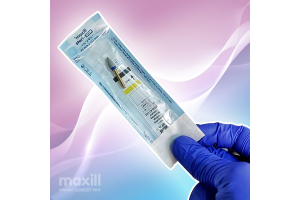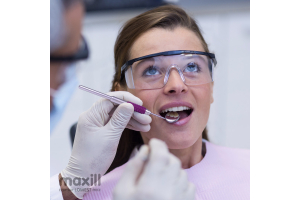Fallow Time Impact on Operatory Turn Over and Clinical Notes Completion

Some provinces require an ACH test and some do not.
Some require adherence to a specific fallow time and some do not.
For the geographical areas that must adhere to a fallow time, the sequence of the operatory turnover and where and when the clinical notes are written is causing some confusion and must be addressed.
A common question is when does the fallow time begin?
The fallow time begins when the clinician and client leave the operatory.
It does NOT begin when the last AGP was performed.
Why?
The reasoning is while the client is still in the operatory conversing with no mask there could be a chance for airborne transmission.
Polishing
Specific to polishing, I have had many inquiries asking if the fallow time can begin as soon as the polish is completed.
This can be answered as no, in pointing out that a rinse is the next step after a polish and the air-water syringe is considered an AGP and again as just stated, the client is still in the room with a risk of having droplets expel as they speak and exhale.
Doffing
The removal of gowns is the next topic.
The clinician’s gown is to be removed at the end of the appointment at the exit of the operatory.
Why?
The clinician cannot be standing mid-operatory to remove the gown then stand and chat ‘gown less’ with the client, then walk out of the operatory as throughout all this time the aerosols are airborne and will settle on the exposed uniform.
As each office is structured differently, the ‘exit’ of the operatory will need to be defined by YOUR office based on the office's availability of space and physical set up.
The office needs to plan gown receptacles, whether it is a disposable gown that requires a garbage or a reusable gown that requires a linen bin, the gown needs to go somewhere.
The doffing of the gown needs to be in a manner that rolls the gown inside out keeping the contaminated outside surface contained.
With a reminder that a soiled gown must be removed and cannot be worn to travel in the office.
This requires coordination of how the client will be handed off to the admin team.
Plan these steps ahead of time to ensure you have a smooth flow and all team members know the new policy and procedural steps.
What about the maintenance of the working space during care?
This is business as usual, pandemic or not, keeping the work area clean is crucial and is part of maintaining asepsis.
This means dispose of your sharps and garbage at point of use and keep your instruments clean at point of use, wiping debris from instruments as required.
We have all experienced the good old spatula caked with cement or adhesive or a scaler with dried blood.
Do yourself and your team a favour and keep a tidy and clean area.
Instruments that need to be dismantled can be dismantled during a procedure if that instrument will no longer be required.
Sharps can still be disposed of at point of use.
A cassette that is no longer being used can be closed.
At point of use can still unfold where it is applicable.
More Questions
'Where it is applicable' is the key phrase that brings the discussion to barriers.
Can barriers be removed during the time the client is still in the room?
The answer is no as this is where it is not applicable when following additional precautions.
In pre-pandemic, under routine practice, an operatory cleanup often began while the DDS was chatting with the client and the dental assistant removes the barriers, may have even had time to don and doff new PPE and begin some of the hard surface disinfecting.
An A+ on efficiency and time management.
In a pandemic under additional precautions, this type of approach is no longer acceptable in the provinces and territories that have directives to adhere to fallow times.
If barriers are removed prior to the exact fallow time, the surface being protected is then subject to the aerosols settling.
Which is Better
Many offices then ask, will pulling off the barrier not create an aerosol and thus having removed it prior to leaving the op had been a better approach?
The other common question, if the surfaces are to be disinfected post barrier removal anyways, what difference does it make if the barrier was pulled off before fallow time end point?
These can be answered by switching your IPAC theory hat from ‘routine practice’ to ‘additional precautions’ and placing a sliding risk ruler on the theory.
The risks are elevated when additional precautions are put in place, therefore the higher potential risk trumps all.
So, the risk of allowing aerosols to settle on a surface that already was barriered is higher than the risk of removing the barrier post fallow time.
Last but not least, can a team member enter the operatory during the fallow time period?
No, once the door is closed (whether your door is solid or the ‘tent’ approach as the zippered plastic), DO NOT RE-ENTER THE OP!
The rationale here is simple … let the dust settle!
The aerosols need to settle on the hard surfaces before the operatory is turned over and the air filters given the time to do their job.
This directly answers the last question, can the clinical notes (chart entry) be written in the operatory during the fallow time as long as nothing is touched and the clinician dons new PPE.
Again, a hard no!
The no this time is truly for the clinicians own protection.
Although in dentistry we are no strangers to an environment of pathogens, in a pandemic scenario with additional precautions, we need to remember the elevated risks.
Conclusion
This entire discussion has a huge practice management impact.
This is why it is so important to plan ahead and entertain a few approaches and options as to how these steps will be executed.
Needing to write a digital chart entry at another station can be an issue when there are no other stations.
Not many offices have the luxury of additional computer stations for record-keeping.
Should anyone at this point be doing a renovation or a new clinic build this truly needs to be taking into consideration.
The day-to-day operations of dentistry have certainly changed and as we continue to navigate in what is our new normal we need to remember an important point, give ourselves a pat on the back for a job well done so far!!!







